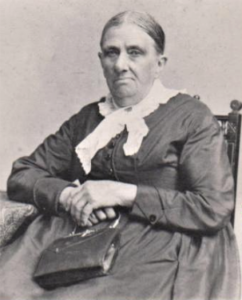Title: Farmer, dairyman
Birthdate: September 8, 1808
Death Date: March 11, 1895
Plot Location: Section 12, Lot 25, south half

Adam Gaul’s father and grandfather were victims of human trafficking. The story of their experience has been preserved through the generations of that family. It is repeated here because slavery of any kind is despicable, yet it is still victimizing people of every race, age, class, and culture. It has occurred as sexual exploitation of children and adults, forced marriage, organ trading, or, in the case of Adam’s ancestors, debt bondage and forced labor.
A Sad Past
Adam’s grandfather, Christian Gaul, decided to leave Germany in 1771 with his wife Barbara and teenage son, John Frederick Gaul. Their ship, the Minerva, left Rotterdam on September 17 bound for Philadelphia. Some of the 204 on board were indentured voluntarily because they were too poor to afford passage. Others were tricked. Soon after setting sail, Christian discovered that his trunks and his cash were missing. He was being set up for extortion by the unscrupulous captain.
They suddenly had nothing. They were forced to draw upon the ship’s supplies, as were others on board who were in the same predicament. Many suffered from poor nutrition and lack of food. Many died as a result, including Barbara, and were simply cast off into the ocean.
To settle their debt for the food they ate, Christian and John were sold into forced labor for a period of seven years. They worked at a camp in “the Neck,” the lowland between the Schuylkill and Delaware Rivers near today’s sports stadiums and FDR Park. What they did is unknown, but the clay soil there was ideal for making bricks, the predominant material used in construction. As John Gaul’s experience was told to future generations, they may have referenced the story of the children of Israel as slaves in Egypt doing the same thing.
Moving On
John served in the Revolutionary War and married in 1783. His first wife bore eight children before her death in 1799, but he remarried in 1804 and had four more, including Adam. A long life expectancy seemed to be in the Gaul genes; of John’s 12 children, 10 lived 70 or more years and three of them were 95 or older when they died. John settled in Kingsessing Township for the rest of his life, presumably as a farmer.
The subject of this Notable story followed his father in farming and expanded into the dairy business. Adam married Harriet Rothwell in 1832 and not only surpassed his father in the number of children, but his were delivered by just one wife. It seems most of their 13 children were also predisposed to longevity, with more than half living to be over 80 years old.
Initially, Adam may have rented the land that he farmed. For a period of time around 1850 the family lived in Lower Merion Township in Montgomery County until they settled in the southwest corner of Philadelphia in 1857. By 1870 three of his adult sons farmed with him, son John lived on the farm next door, and at least two daughters married farmers. Two sons may have rented farmland, one being on Penrose Ferry Road. It’s difficult to imagine farmland in an area that today is flanked by a shuttered oil refinery, tank farms, and an international airport.
By 1880 both Adam and son John had three farm laborers living on the farms where the closest street name was Island Ave. Adam’s farm bordered on Darby Creek, probably north of what is now 84th St. A dairy business prospered, which provided employment for the youngest son, Franklin, who became a milk dealer
In 1882 the children hosted a dinner celebration of their parents’ 50th wedding anniversary with over 150 relatives and friends. One of the gifts from their children and close friends may have been a 
 session at a portrait studio where these photos of the couple were taken. They lived to celebrate their 63rd year together before Adam died of valvular heart disease. Harriet died just one year later. Eight of their children were also buried here at Mount Moriah.
session at a portrait studio where these photos of the couple were taken. They lived to celebrate their 63rd year together before Adam died of valvular heart disease. Harriet died just one year later. Eight of their children were also buried here at Mount Moriah.
Christian Gaul thought he knew the risks he was taking in uprooting his family so his son could have a better life. He and John paid a high price so their descendants would have an opportunity to prosper, and his example was not lost on his children. Adam showed his 13 children, 54 grandchildren, and the untold number of their descendants that bitterness against injustice isn’t fruitful, and the best antidote is the Golden Rule: simply treating others as you would want to be treated.

Support the Friends of Mount Moriah
Help us in our mission to restore and maintain the beautiful Mount Moriah Cemetery by donating to our cause or volunteering at one of our clean-up events.

